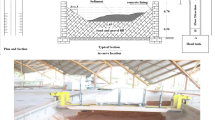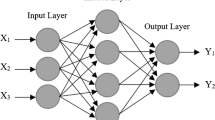Abstract
In the present study, the Group method of data handling (GMDH) network was utilized to predict the scour depth below pipelines. GMDH network was developed using back propagation. Input parameters that were considered as effective parameters on the scour depth included those of sediment size, geometry of pipeline, and approaching flow characteristics. Training and testing performances of the GMDH networks have been carried out using nondimensional data sets that were collected from the literature. These data sets are related to the two main situations of pipelines scour experiments namely clear-water and live-bed conditions. The testing results of performances were compared with the support vector machines (SVM) and existing empirical equations. The GMDH network indicated that using of back propagation produced lower error of scour depth prediction than those obtained using the SVM and empirical equations. Also, the effects of many input parameters on the scour depth have been investigated.




Similar content being viewed by others
References
Amanifard N, Nariman-Zadeh N, Farahani MH, Khalkhali A (2008) Modeling of multiple short-length-scale stall cells in an axial compressor using evolved GMDH neural networks. J Energy Conserv Manag 49(10):2588–2594
Azamathulla HMd, Deo MC, Deolalikar PB (2005) Neural networks for estimation of scour downstream of a ski-jump bucket. J Hydraul Eng ASCE 131(10):898–908
Azamathulla HMd, Deo MC, Deolalikar PB (2008) Alternative neural networks to estimate the scour below spillways. Adv Eng Softw 38(8):689–698
Azamathulla HMd, Ghani AA, Zakaria NA, Guven A (2010) Genetic programming to predict bridge pier scour. J Hydraul Eng ASCE 136(3):165–169
Azamathulla HMd, Guven A, Demir YK (2011) Linear genetic programming to scour below submerged pipeline. Ocean Eng 38(8–9):995–1000
Azamathulla HMd, Zakaria NA (2011) Prediction of scour below submerged pipeline crossing a river using ANN. IWA Water Sci Technol 63(10):2225–2230
Ayoubloo MK, Azamathulla HMd, Jabbari E, Mahjoobi J (2011) Model tree approach for estimation of critical submergence for horizontal intakes in open channel flows. Expert Syst Appl 38(8):10114–10123
Brørs B (1999) Numerical modeling of flow and scour at pipelines. J Hydraul Eng 125–5:511–523
Campbell C (2000) Kernel methods: a survey of current techniques. Neurocomputing 48:63–84
Chao JL, Hennessy PV (1972) Local scour under ocean outfall pipe-lines. Water Pollut Control Federation 44(7):1443–1447
Chiew YM (1991) Prediction of maximum scour depth at submarine pipelines. J Hydraul Eng 117(4):452–466
Chiew YM (1990) Mechanics of local scour around submarine pipelines. J Hydraul Eng 116–4:515–529
Dey S, Singh NP (2007) Clear-water scour depth below underwater pipelines. J Hydro-Environ Res 1:157–162
Debnath K, Chaudhuri S (2010) Laboratory experiments on local scour around cylinder for clay and clay–sand mixed beds. Eng Geol 111(12):51–61
Dey S, Singh NP (2008) Clear-water scour below underwater pipelines under steady flow. J Hydraul Eng 134(5):588–600
Ettema R (1980) Scour at bridge piers. Report No. 216, Deptartment of Civil Engineering, University of Auckland, Auckland, New Zealand
Ettema R, Melville BW, Barkdoll B (1998) Scale effect in pier-scour experiments. J Hydraul Eng 124(6):639–642
Etemad-Shahidi A, Yasa R, Kazeminezhad MH (2011) Prediction of wave-induced scour depth under submarine pipelines using machine learning approach. Appl Ocean Res 33:54–59
Farlow SJ (ed) (1984) Self-organizing method in modeling: GMDH type algorithm. Marcel Dekker Inc, New York
Guven A, Azamathulla HMd (2012) Gene-expression programming for flip bucket spillway scour. Water Sci Technol 65(11):1982–1987
Guven A, Azamathulla HMd, Gunal M (2012) A comparative study of predicting scour around a circular pile. ICE Marit Eng 165(1):31–40
Guven A, Azamathulla HMd, Zakaria NA (2009) Linear genetic programming for prediction of circular pile scour. J Ocean Eng 36(12–13):985–991
Guven A, Gunal M (2008) Genetic programming approach for prediction of local scour downstream hydraulic structures. J Irrig Drain Eng 134(2):241–249
Guven A, Aytek A, Yuce MI, Aksoy H (2008) Genetic programming based empirical model for daily reference evapotranspiration estimation. Clean-Soil Air Water 36(10–11):905–912
Guven A (2009) Linear genetic programming for time series modelling of daily flow rate. J Earth Syst Sci 118(2):137–146
Hansen EA, Fredsøe J, Ye M (1986) Two-dimensional scour below pipelines. In: Proceedings of 5th international symposium on offshore mechanics and arctic engineering, pp 670–678
Ibrahim A, Nalluri C (1986) Scour prediction around marine pipelines. In: Proceedings of the 5th international symposium on offshore mechanics and arctic engineering, pp 679–684
Iba H, de Garis H (1996) Extending genetic programming with recombinative guidance. In: Angeline P, Kinnear K (eds) Advances in genetic programming 2. MIT Press, Cambridge
Ivahnenko AG (1971) Polynomial theory of complex systems. IEEE Trans Syst Man Cybern SMC-1, pp 364–378
Johnson PA (1992) Reliability-based pier scour engineering. J Hydraul Eng ASCE 118(10):1344–1357
Kalantary F, Ardalan H, Nariman-Zadeh N (2009) An investigation on the Su-NSPT correlation using GMDH type neural networks and genetic algorithms. Eng Geol 104(1–2):144–155
Kisi Ö, Guven A (2010) A machine code-based genetic programming for suspended sediment concentration estimation. Adv Eng Softw 41(7–8):939–945
Kjeldsen SP, Gjørsvik O, Bringaker KG, Jacobsen J (1973) Local scour near offshore pipelines. In: Proceedings of the 2nd international conference on port and ocean engineering under arctic conditions, University of Iceland, pp 308–331
Li F, Cheng L (1999) Numerical model for local scour under offshore pipelines. J Hydraul Eng 125(4):400–406
Madala HR, Ivakhnenko AG (1994) Inductive learning algorithms for complex systems modeling. CRC Press, Boca Raton
Maza JA (1987) Introduction to river engineering. Advanced course on water resources management. Universitá Italiana per Stranieri, Perugia
Myrhaug D, Rue H (2003) Scour below pipelines and around vertical piles in random waves. Coast Eng 48(4):227–242
Myrhaug D, Ong MC, Føien H, Gjengedal C, Leira BJ (2009) Scour below pipelines and around vertical piles due to second-order random waves plus a current. Ocean Eng 36:605–616
Mehrara M, Moeini A, Ahrari M, Erfanifard A (2009) Investigating the efficiency in oil futures market based on GMDH approach. Expert Syst Appl 36(4):7479–7483
Moncada-M AT, Aguirre-Pe J (1999) Scour below pipeline in river crossings. J Hydraul Eng 125(9):953–958
Melville BW (1984) Live-bed scour at bridge piers. J Hydraul Eng ASCE 110(9):1234–1247
Najafzadeh M (2009) Experimental and numerical study of local scour around a vertical pier in cohesive soils, Ms. Thesis, Shahid Bahonar University, Kerman, Iran
Najafzadeh M, Barani Gh-A (2011) Comparison of group method of data handling based genetic programming and back propagation systems to predict scour depth around bridge piers. Scientia Iranica Trans A Civil Eng 18(6):1207–1213
Najafzadeh M, Barani G-A (2012) Discussion of “Genetic programming to predict river pipeline scour” by HMd Azamathulla and Aminuddin, Ab Ghani. J Pipeline Syst Eng Pract ASCE
Najafzadeh M, Azamathulla HM (2012) Group method of data handling to predict scour depth around bridge piers. Neural Comput Appl. doi:10.1007/S00521-021-1160-6
Najafzaded M, Barani G-A, Hessami Kermani MR (2012) Abutment scour in clear-water and live-bed conditions by GMDH network. Water Sci Technol. doi:10.2166/wst.2012.670
Nariman-Zadeh N, Darvizeh A, Ahmad-Zadeh GR (2003) Hybrid genetic design of GMDH-type neural networks using singular value decomposition for modelling and prediction of the explosive cutting process. Proc Inst Mech Eng Part B J Eng Manuf 217:779–790
Onwubolu GC (2008) Design of hybrid differential evolution and group method in data handling networks for modeling and prediction. Inform Sci 178:3618–3634
Sanchez E, Shibata T, Zadeh LA (1997) Genetic algorithms and fuzzy logic systems. World Scientific, Singapore
Sakaguchi A, Yamamoto T (2000) A GMDH network using back propagation and its application to a controller design. J IEEE 4:2691–2697
Sheppard DM, Miller W (2006) Live-bed local pier scour experiments. J Hydraul Eng 132(7):635–642
Srinivasan D (2008) Energy demand prediction using GMDH networks. Neuro Comput 72(1–3):625–629
Smola AJ, Scholkopf B (2004) A tutorial on support vector regression. Statis Comput 14(3):199–222
Toth E, Brandimarte L (2011) Prediction of local scour depth at bridge piers under clear-water and live-bed conditions: comparison of literature formulae and artificial neural networks. J Hydroinform 13(4):812–824
Vapnik VN (1995) The nature of statistical learning theory. Springer, New York
Witczak M, Korbicz J, Mrugalski M, Patton R (2006) A GMDH neural network-based approach to robust fault diagnosis: application to the DAMADICS benchmark problem. Control Eng Pract 14(6):671–683
Author information
Authors and Affiliations
Corresponding author
Rights and permissions
About this article
Cite this article
Najafzadeh, M., Barani, GA. & Azamathulla, H.M. Prediction of pipeline scour depth in clear-water and live-bed conditions using group method of data handling. Neural Comput & Applic 24, 629–635 (2014). https://doi.org/10.1007/s00521-012-1258-x
Received:
Accepted:
Published:
Issue Date:
DOI: https://doi.org/10.1007/s00521-012-1258-x




